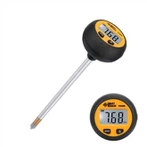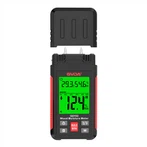Three major categories of infrared thermometers
(1) Human infrared thermometer: The forehead type infrared thermometer is a thermometer that uses the principle of infrared reception to measure the human body. When using it, you only need to conveniently align the detection window with the forehead, and the human body temperature can be measured quickly and accurately.
(2) Industrial infrared thermometer: The industrial infrared thermometer measures the surface temperature of an object. Its light sensor radiates, reflects and transmits energy. The energy is then collected and focused by the probe, and then other circuits convert the information into a reading display. Onboard, the machine is equipped with a laser light that can more effectively align the object being measured and improve measurement accuracy.
(3) Animal infrared thermometer for animal husbandry: The veterinary infrared non-contact thermometer is based on Planck's principle and can accurately measure the surface temperature of specific parts of the animal's body surface and correct the temperature difference between the surface temperature and the actual temperature. It can accurately display the individual body temperature of animals.
Determine the wavelength range: The emissivity and surface properties of the target material determine the spectral response, or wavelength, of the thermometer. For high reflectivity alloy materials, there is low or varying emissivity. In high-temperature areas, the best wavelength for measuring metallic materials is near-infrared, and 0.18-1.0 μm wavelength can be used. Other temperature zones can use 1.6μm, 2.2μm and 3.9μm wavelengths. Since some materials are transparent at certain wavelengths, infrared energy will penetrate these materials, and a special wavelength should be selected for this material. For example, when measuring the internal temperature of glass, use 10 μm, 2.2 μm and 3.9 μm wavelengths (the glass to be measured must be very thick, otherwise it will be transmitted through); when measuring the internal temperature of glass, use 5.0 μm wavelength; when measuring low temperatures, it is appropriate to use 8-14 μm wavelengths. ; Another example is to measure the wavelength of 3.43μm for polyethylene plastic film, and the wavelength of 4.3μm or 7.9μm for polyester.
Determine the response time: The response time represents the response speed of the infrared thermometer to the measured temperature change. It is defined as the time required to reach 95% of the energy of the final reading. It is related to the time constant of the photodetector, signal processing circuit and display system. The response time of the new infrared thermometer can reach 1ms. This is much faster than the contact temperature measurement method. If the target moves very fast or when measuring a rapidly heated target, a fast-response infrared thermometer should be used. Otherwise, sufficient signal response will not be achieved and the measurement accuracy will be reduced. However, not all applications require a fast-responding infrared thermometer. When there is thermal inertia for stationary or target thermal processes, the response time of the thermometer can be relaxed. Therefore, the choice of the response time of the infrared thermometer must be adapted to the conditions of the target being measured.






